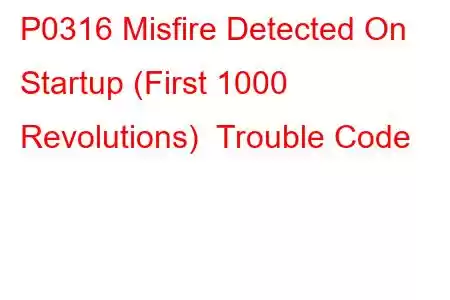P0316 Engine Misfire at Startup
OBD-II Trouble Code Technical Description
Engine Misfire Detected on Startup (First 1000 Revolutions)
What does that mean?
This diagnostic trouble code (DTC) is a generic powertrain code, which means that it applies to OBD-II equipped vehicles. Although generic, the specific repair steps may vary depending on make/model.
This P0316 code means the powertrain control module (PCM) has detected a misfire shortly after startup, specifically within the first 1,000 revolutions.
This code may also be triggered with another of the other misfire codes which are P0300, P0301, P0302, P0303, P0304, P0305, P0306, P0307, P0308, P0309, P0310, P0311, P0312. If you have another misfire trouble code also, you should diagnose and repair that code(s) first.
Symptoms
Symptoms of a P0316 DTC may include:
MIL (Malfunction indicator lamp) illumination Rough engine start or idlePotential Causes
Potential causes of this misfire code may include:
Damaged or defective Crankshaft Position Sensor (CKP) CKP sensor wiring or connector fault Poor fuel quality Ran out of fuel Ignition system malfunction Fuel system malfunction: injector or fuel pump Mechanical engine problem Damaged PCMPossible Solutions
First off, you'll want to repair any other misfire DTC codes if present prior to diagnosing this code. If you own a Ford vehicle and you have a P0316 along with one of the other misfire codes, you should check for appropriate TSBs (technical service bulletins), as there are some TSBs that in part involve reprogramming the PCM. Doing that requires specialized equipment. Some Ford vehicles even needed a new cylinder head as a result of the valve. Regardless, if you have a Ford with multiple misfire codes including this one, check for TSBs.
If the P0316 is the only code, then it's time to do a bit more diagnosing of the crankshaft and camshaft position sensors, and their associated connectors and wiring. A tip we've found is "Since this code indicates a start up misfire, pay attention to items which may expand or contract when cold (if the code sets when the engine is cold), or hot (if the code sets on a hot restart)."
Realistically, the freeze frame data from the PCM will be helpful in tracking down the problem. As will a good DVOM (digital volt-ohm meter), so you can perform tests on the wiring and the sensors.
Read: 51


